#Database Systems Design Implementation
Explore tagged Tumblr posts
Text
Lancer Tactics dialogue layout crisis of faith
(from this month's backer update)
Every so often, I'll run into something in development that eats away at me until it pushes me to a crisis of faith and I have a breakdown, burn down a bunch of work, and build something better from the ashes. These are moments of transformation and we're almost always able to come out the other side with something much better than what we started with.
This all sounds very dramatic until you take a step back and see the issue in question is just, like, the layout of a menu. But if medieval priests were able to have schisms over angels on pins I can have strong feelings about graphic design, dammit!
This month's episode revolved around how we're doing character dialogue. For reference the plan was to do a standard 4-slot visual-novel talking heads layout. I call it a 4-slot because there's usually four positions that characters can stand; two on the left, two on the right:
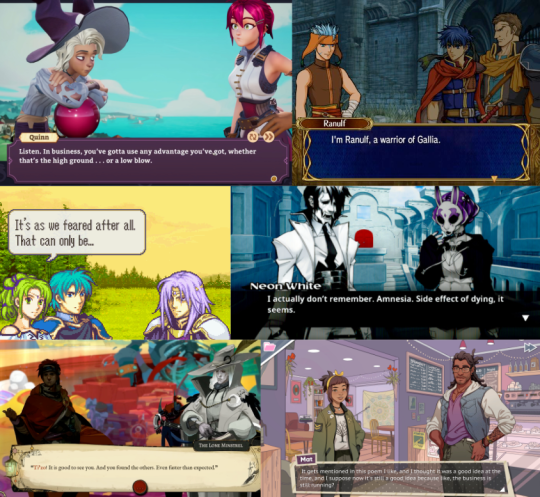
I had it ingame, and it was working. But... something felt off. Do you see the difference between every one of the above examples and this?
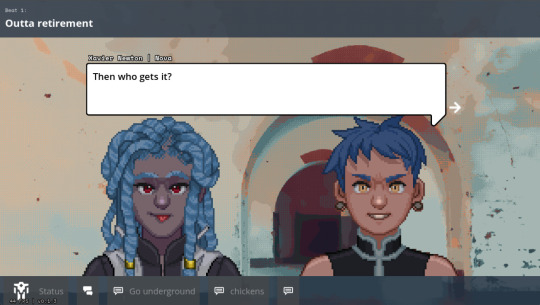
It's all about perspective, baby.
Answer: all the character art in those examples are drawn at a slight angle so they can be flipped back and forth to be made like they're looking at each other.
Trying to do this with the perspective we chose early — straight on — makes for a chorus line of weirdos who are looking directly into your soul as they ostensibly chat with each other. Credulity is strained; the illusion of these puppets interacting in the same space is paper-thin.
(I was skeptical of choosing this perspective for this reason, but we ultimately went with it to make the customizable assets in the portrait maker easier to fit together)
We tried a bunch of different layouts, but they all at least one of these problems:
they'd stare into your soul while ostensibly directing comments elsewhere.
they felt like text messages; this would be fine if that's what we were going for, but we wanted something that could represent face-to-face conversations. (Tactical Breach Wizards was able to pull this style off because they had little 3D dioramas to go along with it)
or, most damning of all, they felt like zoom calls.
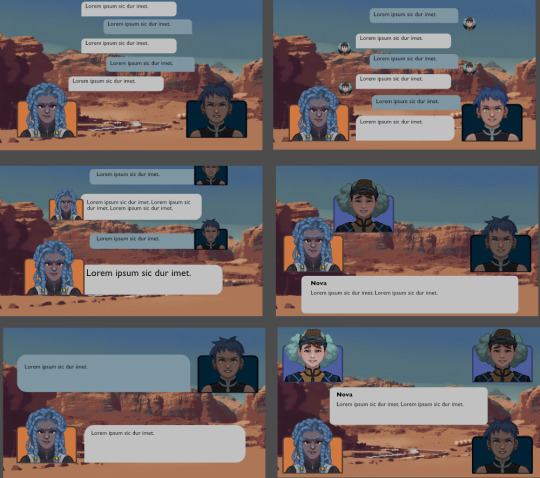
So, my heart aflutter and spirit in want, I spent a day doing a research dive into various dialogue layouts (bless the Game UI Database!) to see if any other games had managed to pull this character art perspective off. I ended up with this massive non-chronological taxonomic tree:
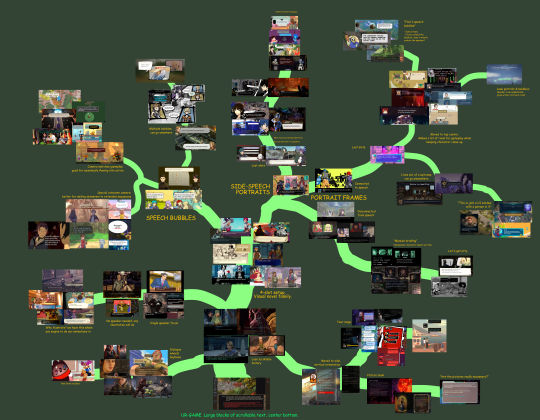
(fullsize here)
The type of layout that particularly caught my eye was this style where each character had their own little box. These layouts borrow a concept from comic books called "closure" where the space and time between characters are left blank. Freed from the constraints of trying to simulate a single space, these layouts allow the reader to fill in the blanks with something that feels more true-to-life than anything we'd be able to render ourselves.
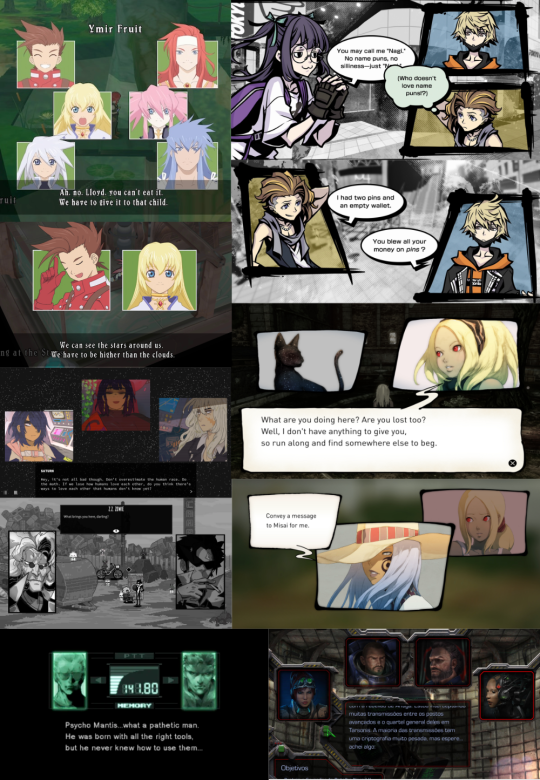
I was especially impressed with the dynamism of Tales of Symphonia and The World Ends With You; rather than sticking to single slots they would animate the entire panels moving around to indicate motion an relative position of characters.
So we threw out the old code and copied them. Here's what we've come up with:
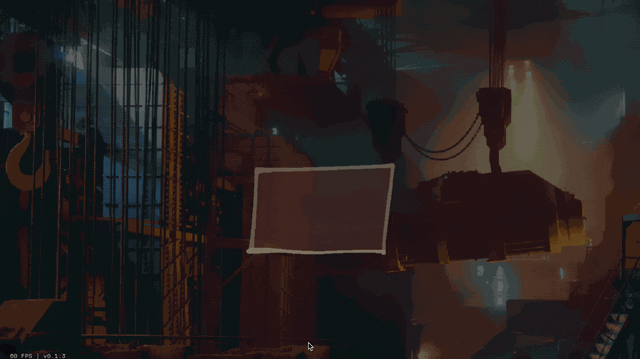
We'll be able to have portraits interact, like smacking each other (I felt like a kid hitting two action figures together, lol)
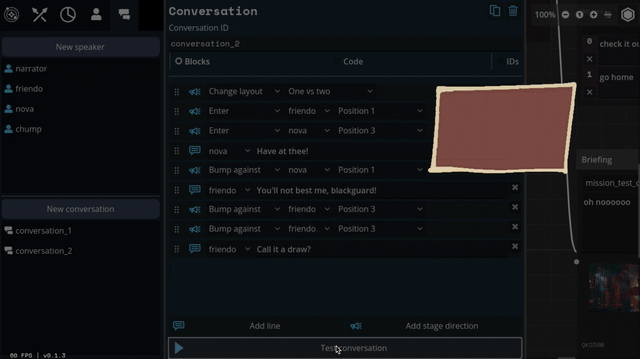
We can also apply effects like princess-leia-holograms and full-screen "lighting" effects like warning banners:
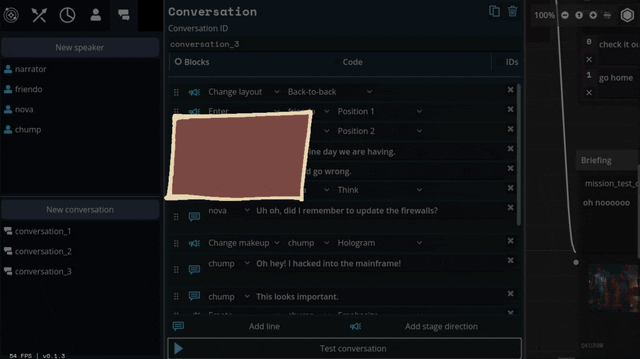
Carpenter and I came up with a number of arrangements that the portraits can smoothly transition between:


I've also implemented support for choices during a dialogue, potentially leading to branching paths.

Overall, I feel SO much better about this system than our initial designs. It might feel a little more cartoony, but I think we're making a cartoony game so that's not a problem.
Whew. We bit a lot off to chew with this project. I feel like I just made a second visual novel game engine inside of the first. Fingers crossed that it all ends up worth it.
475 notes
·
View notes
Note
komaedas have you tried straw.page?
(i hope you don't mind if i make a big ollllle webdev post off this!)
i have never tried straw.page but it looks similar to carrd and other WYSIWYG editors (which is unappealing to me, since i know html/css/js and want full control of the code. and can't hide secrets in code comments.....)
my 2 cents as a web designer is if you're looking to learn web design or host long-term web projects, WYSIWYG editors suck doodooass. you don't learn the basics of coding, someone else does it for you! however, if you're just looking to quickly host images, links to your other social medias, write text entries/blogposts, WYSIWYG can be nice.
toyhouse, tumblr, deviantart, a lot of sites implement WYSIWYG for their post editors as well, but then you can run into issues relying on their main site features for things like the search system, user profiles, comments, etc. but it can be nice to just login to your account and host your information in one place, especially on a platform that's geared towards that specific type of information. (toyhouse is a better example of this, since you have a lot of control of how your profile/character pages look, even without a premium account) carrd can be nice if you just want to say "here's where to find me on other sites," for example. but sometimes you want a full website!
---------------------------------------
neocities hosting
currently, i host my website on neocities, but i would say the web2.0sphere has sucked some doodooass right now and i'm fiending for something better than it. it's a static web host, e.g. you can upload text, image, audio, and client-side (mostly javascript and css) files, and html pages. for the past few years, neocities' servers have gotten slower and slower and had total blackouts with no notices about why it's happening... and i'm realizing they host a lot of crypto sites that have crypto miners that eat up a ton of server resources. i don't think they're doing anything to limit bot or crypto mining activity and regular users are taking a hit.



↑ page 1 on neocitie's most viewed sites we find this site. this site has a crypto miner on it, just so i'm not making up claims without proof here. there is also a very populated #crypto tag on neocities (has porn in it tho so be warned...).
---------------------------------------
dynamic/server-side web hosting
$5/mo for neocities premium seems cheap until you realize... The Beautiful World of Server-side Web Hosting!
client-side AKA static web hosting (neocities, geocities) means you can upload images, audio, video, and other files that do not interact with the server where the website is hosted, like html, css, and javascript. the user reading your webpage does not send any information to the server like a username, password, their favourite colour, etc. - any variables handled by scripts like javascript will be forgotten when the page is reloaded, since there's no way to save it to the web server. server-side AKA dynamic web hosting can utilize any script like php, ruby, python, or perl, and has an SQL database to store variables like the aforementioned that would have previously had nowhere to be stored.
there are many places in 2024 you can host a website for free, including: infinityfree (i use this for my test websites :B has tons of subdomains to choose from) [unlimited sites, 5gb/unlimited storage], googiehost [1 site, 1gb/1mb storage], freehostia [5 sites/1 database, 250mb storage], freehosting [1 site, 10gb/unlimited storage]
if you want more features like extra websites, more storage, a dedicated e-mail, PHP configuration, etc, you can look into paying a lil shmoney for web hosting: there's hostinger (this is my promocode so i get. shmoney. if you. um. 🗿🗿🗿) [$2.40-3.99+/mo, 100 sites/300 databases, 100gb storage, 25k visits/mo], a2hosting [$1.75-12.99+/mo, 1 site/5 databases, 10gb/1gb storage], and cloudways [$10-11+/mo, 25gb/1gb]. i'm seeing people say to stay away from godaddy and hostgator. before you purchase a plan, look up coupons, too! (i usually renew my plan ahead of time when hostinger runs good sales/coupons LOL)
here's a big webhost comparison chart from r/HostingHostel circa jan 2024.

---------------------------------------
domain names
most of the free website hosts will give you a subdomain like yoursite.has-a-cool-website-69.org, and usually paid hosts expect you to bring your own domain name. i got my domain on namecheap (enticing registration prices, mid renewal prices), there's also porkbun, cloudflare, namesilo, and amazon route 53. don't use godaddy or squarespace. make sure you double check the promo price vs. the actual renewal price and don't get charged $120/mo when you thought it was $4/mo during a promo, certain TLDs (endings like .com, .org, .cool, etc) cost more and have a base price (.car costs $2,300?!?). look up coupons before you purchase these as well!
namecheap and porkbun offer something called "handshake domains," DO NOT BUY THESE. 🤣🤣🤣 they're usually cheaper and offer more appealing, hyper-specific endings like .iloveu, .8888, .catgirl, .dookie, .gethigh, .♥, .❣, and .✟. I WISH WE COULD HAVE THEM but they're literally unusable. in order to access a page using a handshake domain, you need to download a handshake resolver. every time the user connects to the site, they have to provide proof of work. aside from it being incredibly wasteful, you LITERALLY cannot just type in the URL and go to your own website, you need to download a handshake resolver, meaning everyday internet users cannot access your site.
---------------------------------------
hosting a static site on a dynamic webhost
you can host a static (html/css/js only) website on a dynamic web server without having to learn PHP and SQL! if you're coming from somewhere like neocities, the only thing you need to do is configure your website's properties. your hosting service will probably have tutorials to follow for this, and possibly already did some steps for you. you need to point the nameserver to your domain, install an SSL certificate, and connect to your site using FTP for future uploads. FTP is a faster, alternative way to upload files to your website instead of your webhost's file upload system; programs like WinSCP or FileZilla can upload using FTP for you.
if you wanna learn PHP and SQL and really get into webdev, i wrote a forum post at Mysidia Adoptables here, tho it's sorted geared at the mysidia script library itself (Mysidia Adoptables is a free virtual pet site script, tiny community. go check it out!)
---------------------------------------
file storage & backups
a problem i have run into a lot in my past like, 20 years of internet usage (/OLD) is that a site that is free, has a small community, and maybe sounds too good/cheap to be true, has a higher chance of going under. sometimes this happens to bigger sites like tinypic, photobucket, and imageshack, but for every site like that, there's like a million of baby sites that died with people's files. host your files/websites on a well-known site, or at least back it up and expect it to go under!
i used to host my images on something called "imgjoe" during the tinypic/imageshack era, it lasted about 3 years, and i lost everything hosted on there. more recently, komaedalovemail had its webpages hosted here on tumblr, and tumblr changed its UI so custom pages don't allow javascript, which prevented any new pages from being edited/added. another test site i made a couple years ago on hostinger's site called 000webhost went under/became a part of hostinger's paid-only plans, so i had to look very quickly for a new host or i'd lose my test site.
if you're broke like me, looking into physical file storage can be expensive. anything related to computers has gone through baaaaad inflation due to crypto, which again, I Freaquing Hate, and is killing mother nature. STOP MINING CRYPTO this is gonna be you in 1 year

...um i digress. ANYWAYS, you can archive your websites, which'll save your static assets on The Internet Archive (which could use your lovely donations right now btw), and/or archive.today (also taking donations). having a webhost service with lots of storage and automatic backups can be nice if you're worried about file loss or corruption, or just don't have enough storage on your computer at home!
if you're buying physical storage, be it hard drive, solid state drive, USB stick, whatever... get an actual brand like Western Digital or Seagate and don't fall for those cheap ones on Amazon that claim to have 8,000GB for $40 or you're going to spend 13 days in windows command prompt trying to repair the disk and thenthe power is gong to go out in your shit ass neighvborhood and you have to run it tagain and then Windows 10 tryes to update and itresets the /chkdsk agin while you're awayfrom town nad you're goig to start crytypting and kts just hnot going tot br the same aever agai nikt jus not ggiog to be the saeme
---------------------------------------
further webhosting options
there are other Advanced options when it comes to web hosting. for example, you can physically own and run your own webserver, e.g. with a computer or a raspberry pi. r/selfhosted might be a good place if you're looking into that!
if you know or are learning PHP, SQL, and other server-side languages, you can host a webserver on your computer using something like XAMPP (Apache, MariaDB, PHP, & Perl) with minimal storage space (the latest version takes up a little under 1gb on my computer rn). then, you can test your website without needing an internet connection or worrying about finding a hosting plan that can support your project until you've set everything up!
there's also many PHP frameworks which can be useful for beginners and wizards of the web alike. WordPress is one which you're no doubt familiar with for creating blog posts, and Bluehost is a decent hosting service tailored to WordPress specifically. there's full frameworks like Laravel, CakePHP, and Slim, which will usually handle security, user authentication, web routing, and database interactions that you can build off of. Laravel in particular is noob-friendly imo, and is used by a large populace, and it has many tutorials, example sites built with it, and specific app frameworks.
---------------------------------------
addendum: storing sensitive data
if you decide to host a server-side website, you'll most likely have a login/out functionality (user authentication), and have to store things like usernames, passwords, and e-mails. PLEASE don't launch your website until you're sure your site security is up to snuff!
when trying to check if your data is hackable... It's time to get into the Mind of a Hacker. OWASP has some good cheat sheets that list some of the bigger security concerns and how to mitigate them as a site owner, and you can look up filtered security issues on the Exploit Database.
this is kind of its own topic if you're coding a PHP website from scratch; most frameworks securely store sensitive data for you already. if you're writing your own PHP framework, refer to php.net's security articles and this guide on writing an .htaccess file.
---------------------------------------
but. i be on that phone... :(
ok one thing i see about straw.page that seems nice is that it advertises the ability to make webpages from your phone. WYSIWYG editors in general are more capable of this. i only started looking into this yesterday, but there ARE source code editor apps for mobile devices! if you have a webhosting plan, you can download/upload assets/code from your phone and whatnot and code on the go. i downloaded Runecode for iphone. it might suck ass to keep typing those brackets.... we'll see..... but sometimes you're stuck in the car and you're like damn i wanna code my site GRRRR I WANNA CODE MY SITE!!!


↑ code written in Runecode, then uploaded to Hostinger. Runecode didn't tell me i forgot a semicolon but Hostinger did... i guess you can code from your webhost's file uploader on mobile but i don't trust them since they tend not to autosave or prompt you before closing, and if the wifi dies idk what happens to your code.
---------------------------------------
ANYWAYS! HAPPY WEBSITE BUILDING~! HOPE THIS HELPS~!~!~!
-Mod 12 @eeyes

198 notes
·
View notes
Note
Hi there, Love your work! I'm also doing stuff in Unreal and it feels like it's rarer to find other indie devs using it. I love how clean all your UI feels, and UI is something I seem to really struggle with.
Do you have any recommendations for workflows / tips / sources etc for getting better at UI?
Also I'd love to know more about the material / shader workflow for your latest post if you have more information anywhere.
Thanks :)
Hello there! Thank you!! I hope you don't mind me answering publicly as I feel like some people might be interested in the answer!
I really appreciate your UI (User Interface for those not knowing the acronym) compliment as it's something I've spent a long time working on and specializing in, in my career as a software engineer. UI/UX often goes completely unacknowledged or taken for granted even though it takes a lot of time and hard work to create and develop. In the engineering world I frequently had to advocate for and explain user experiences to those who didn't have as deep of an appreciation for UI or a very sophisticated understanding of why a good, visually appealing user experience makes, or on the flip side, can break everything. I think it's a very challenging, overwhelming topic to grasp and communicate, but just by being interested in it you're already way ahead!
There's a lot going on with UI. From visuals to knowing common design elements to successfully conveying a story to the user to implementation to testing to designing for accessibility to animation and I probably didn't cover everything with that run-on sentence. There's frontend engineers out there whose role is solely to maintain and improve UI component libraries for companies. And that's without throwing games, whose UIs are all uniquely visually tailored to their experiences, into the mix... I could keep going on about this honestly, but I'll get to what I think you can do personally! 1. Learn about common design patterns. What's a toast? What's pagination? What's a card? Little things like that. These apply to all software UI/UX, including video games- and knowing these off the top of your head will make it so much easier for you to invent your own UI designs and patterns.
2. Study the UI in the everyday applications you interact with. Step through menus and think about how you got from point A to point B. Take a moment to think about the why someone put a button where they did. Study the UI in your favorite video games, too! Take a lot of notes on what you think works really well and what you think doesn't. And also there's online resources that are great for inspiration. I personally spend a lot of time on the Game UI Database. - https://dribbble.com/ - https://www.gameuidatabase.com/ 3. Don't be afraid to start with basic sketches or even just simply representing everything with grey boxes. All my UI starts out as really crappy sketches on paper, or tablet sketches on top of screenshots. Visualize your ideas and then keep iterating on them until you've got something. For example, I went from this:
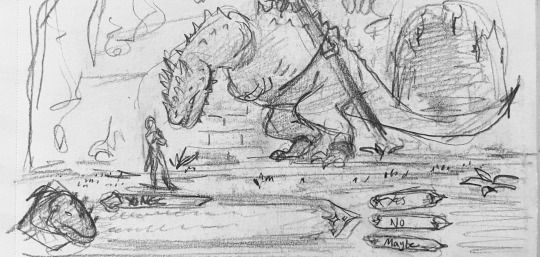

To this. (And come to think of it I might actually still want to make those cooler looking buttons in my sketch) 4. Break everything out into pieces and individual components. A good UI is made up of building blocks that you can reuse all over the place. That's how it stays consistent and also saves you a lot of stress when you need to go in and update components. Instead of a million different looking UI pieces, you just have to update the one! These individual components will make up your very own UI Component Library, which will be the standardized design system and source of reusable components for your project. This also applies to your visual elements that don't do anything (like I personally have a whole mini library of diamond and star shapes that I reuse everywhere).
For reference, here's a breakdown I made of my Inventory UI. On the right, I've labeled most of the individual components, and you might be able to see how I'm reusing them over and over again in multiple places.

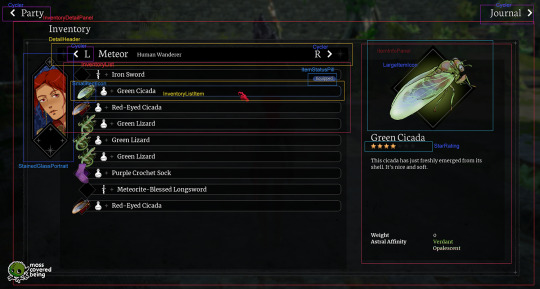
5. Spend some time listening to designers talk, maybe befriend some designers! Many of them have an unique, interesting view of the world and how we interact with it even beyond just software. Their perspectives will inform yours.
6. Test your UI on users whenever you can. Get feedback from others. This is the best way for you to see what works and what doesn't. As game devs we spend so much time with our games it's easy for us to lose sight of the full picture.
7. Be patient and don't give up. Continue to be open to expanding your knowledge. These UI skills take time to develop. I personally am still learning even after like 10 years of doing it. Coming up with the visual elements is very challenging for me and I spend a lot of time rearranging things in photoshop before I actually start coding anything at all in Unreal.
Whew, that was a lot, but I hope that gives you some thoughts and a place to start!
I don't have any posts out there about Blender/Unreal shader workflows right now, but I'll consider making another post sometime soonish. I appreciate you asking and you're welcome! :)
23 notes
·
View notes
Text

@sleepy-spaceman thank you my creature. Thank you
In a different post, I went over the basics of how AI work in my little OC universe, Rift Saga (a tentative title for now) and I’ve recently come up with another subclass under the sentient AI category. These AI are called exoplanetary scope AI (EPSAI), and were made for scientific expeditions on unexplored or new planets.
They’ve got the bare basics to be considered sentient AI. Personality database, though only bland and generally lacking in any particularly notable attributes, separate memory cores (personal and functional), and a vocal system for language communications. The thing that makes exoplanetary scope AI unique, however, is the presence of a physical body that contributes to the work the AI is doing on their exoplanet. These bodies are quite barebones, all considering. They’re designed for functionality and not for appearance, and only vaguely have a “human” silhouette. Their anatomies (which is what the EPSAI’s physical vessels are called) are very geometric and shaped, and their appearances vary based on what the exoplanet’s environment consists of. Proportions can vary, along with different protective sealants and coatings applied to the anatomies that also gives a “painted” appearance, but again, it’s all for functionality. They aren’t even given names beyond a factory number or maybe being named after their exoplanet—it was all about their work, and they really didn’t have anything that was just for them.
EPSAI only have their one use. They are meant to do their job, testing the planets materials, taking measurements, everything that would need to be made known to humans to determine whether or not that exoplanet is able and worth colonizing. And after, everything is recycled, including the AI. Their processors are stripped of memories and personalities, reduced to the “factory settings” so to speak, and their anatomies are dismantled and reused elsewhere. They go through a processing checkpoint following their departure off-planet (that is only if the planet is deemed worthy of colonization, otherwise the EPSAI are left to deactivate on their own time, all forms of communication with humans cut), where they’re supposed to be cleared for dismantle. However, all that began to change once a new presence showed up.
They don’t have a name, but they’re referred to as “The Liberators”—humans who raid AI processing checkpoints who smuggle out the former scope AI to then bring them to a planet who has in recent years, built an economy based around tourism and bot rings. It is made clear following their escape that the Liberators don’t do anything for free, and the former scope AI are indebted to them. In return, the AI are given new lives as the hottest entertainment seen in recent centuries, even millennia, for money. It works as a pretty basic bet-and-pay system; put your money on a bot, and if they win you get your money back plus more, and if you lose, well, you’re outta luck.
Previously, the AI are considered to be the barest form of autonomous, but here? They’re figureheads for a different kind of life. The one physical requirement to be enlisted under the Liberators in a bot ring is the implementation of pain simulant nanites, much like how human pain receptors work, just to make it a little more real. Beyond that, there is a rising trend in flashy mods and paint jobs to draw in more betters and really put on a show. Here, they also gain a stronger sense of self, forging names and new identities.
After paying off whatever debts are owed, the AI are free to do whatever they like on-planet. The rings are a well-kept little secret, and they’d like to keep it that way. Many stay in the ring business, often getting employed under new organizations to keep fighting. But because the AI are only known for their fighting, it’s the only thing that the human settlers treat them as. Mere entertainment and an easy way to make some extra cash. It’s extremely difficult to “live a life” outside of the rings for bots, which is why so many tend to stay. I mentioned debt peonage in my original post about this. It was a common practice following the US Civil War for African Americans to work to pay off their debts, but because there was still widespread racial discrimination against them, the only places that would take African Americans into work were plantations in the southern US. It kept the labor needed to run plantations, just on a altered plane. Similarly, that is what happens here with the bots. And, at the same time, they’re put onto these pedestals because of their capabilities.
It’s a highly hypocritical practice, but that’s the way it’s been.
A lot of the inspiration for this came from a movie called Real Steel (2011), which I suggest looking up especially for visual designs, because it’s quite similar to how I imagine the designs of the AI looking.
11 notes
·
View notes
Text
Very funny to see "guy breaks security device which inexplicably unlocks everything" in fiction because you'd assume that would be a bad thing to implement, but from personally studying security procedures, it's actually completely in line with the standard.
There's an adage called "Fail Safe." Not "failsafe," two words. If your system is going to fail, you want it to fail in a manner that's safe for the people using it. If your building's key card system goes down, all of the doors will unlock because if the cause of the failure is... idk a building fire, having every single door permanently lock itself is going to kill people.
When it comes to security, specifically cybersecurity in my case, we're advised to design systems that prioritize human life over property and information.
There's an inverse adage that's "Fail Secure" which is for purely digital spaces. Like if a firewall that vets people trying to access a database goes kaput, the entire system is designed to shut off and become inaccessible, because usually not having the data right this moment isn't going to kill someone.
Physical security is "Fail safe." Digital security is "Fail secure."
4 notes
·
View notes
Text
Thailand Visa Exemptions
1. Legislative Framework and Policy Evolution
1.1 Statutory Basis
Governed by Sections 12 and 35 of the Immigration Act B.E. 2522 (1979)
Implemented through Ministerial Regulation No. 28 (B.E. 2544)
Modified by Cabinet Resolution (November 2022) extending 45-day stays until November 2025
1.2 Bilateral vs. Unilateral Agreements
Reciprocal Exemptions (12 countries including Brazil, South Korea, Peru)
90-day stays
Multiple-entry privileges
Unilateral Exemptions (56 countries)
Standard 30-day stays
45-day temporary extension for air arrivals
1.3 Historical Policy Shifts
2008: Introduction of 15-day land border restrictions
2016: Implementation of biometric tracking
2022: Temporary 45-day extension to boost tourism
2. Eligibility and Entry Protocols
2.1 Nationality-Based Classification
Passport TypeDurationEntry MethodExtension EligibilityG7 Nations45 days*Air onlyYes (30 days)ASEAN Members30 daysAir/LandNoDeveloping Economies15-30 daysConditionalVaries
*Until November 2025 per Cabinet Resolution
2.2 Document Verification Matrix
Mandatory Documents:
Passport (6+ months validity)
Onward ticket (confirmed within exemption period)
Proof of funds (THB 20,000/person)
Secondary Checks:
Previous Thai visa history (12-month lookback)
Accommodation verification
3. Immigration Assessment Algorithms
3.1 Risk-Based Screening System
Primary Inspection:
Machine-readable zone scan
Interpol database check
Facial recognition matching
Secondary Screening Triggers:
4+ visa exemptions in 12 months
Suspicious travel patterns
Incomplete documentation
3.2 Discretionary Denial Factors
Red Flags:
Previous overstays (even if paid)
Employment-seeking behavior
Frequent border runs
4. Border-Specific Implementation
4.1 Airport Processing
Dedicated Visa-Exempt Lanes at 6 international airports
Automated Immigration Gates (e-Gates) for eligible nationalities
Transit Without Visa (TWOV):
72-hour limit
Confirmed onward ticket required
4.2 Land Border Restrictions
15-Day Maximum Stay at 52 designated checkpoints
Entry Quotas:
2 land crossings per calendar year (2024 policy)
Exceptions for border pass holders
5. Extension and Conversion Mechanics
5.1 Extension of Stay
Single 30-Day Extension:
THB 1,900 fee
TM.7 form submission
Proof of address required
Exceptional Cases:
Medical treatment
Force majeure events
5.2 Visa Conversion Options
Non-Immigrant Pathways:
Business (B): Requires THB 25,000 application fee
Retirement (O): Age 50+ with financial proof
Education (ED): Enrollment in accredited institution
6. Compliance and Enforcement
6.1 Overstay Penalties
Fine Structure:
THB 500/day (maximum THB 20,000)
Automatic blacklisting after 90+ days
Voluntary Departure Program:
7-day grace period at airports
6.2 Visa-Run Monitoring
Automated Tracking System:
Flags frequent exempt entries
Calculates denial probability score
7. Special Case Analyses
7.1 Diplomatic/Official Passports
90-Day Exemption regardless of nationality
Exempt from:
Financial proof requirements
Onward ticket verification
7.2 Crew Member Privileges
72-Hour Shore Leave:
Valid with approved crew documentation
Separate from passenger exemptions
8. Emerging Policy Developments
9.1 Digital Integration
E-Arrival Card System (2024 rollout)
Blockchain Travel History (Phase 1 testing)
9.2 Security Enhancements
Biometric Exit System (Full implementation 2025)
API Integration with INTERPOL databases
9. Strategic Entry Planning
10.1 For Frequent Travelers
Alternative Solutions:
METV (6-month multiple entry)
Elite Visa (5-20 year options)
Entry Pattern Management:
Minimum 21-day intervals between exempt entries
Rotate entry points (BKK/DMK/HKT)
10.2 For Long-Term Stays
Conversion Timing:
Optimal window: Days 1-15 of entry
Avoid holiday periods
Document Preparation:
Pre-legalized paperwork
Financial trail establishment
#thailand#immigration#thai#thailandvisa#thaivisa#visa#immigrationinthailand#thaivisaexemptions#thailandvisaexemptions#visaexemptions
3 notes
·
View notes
Text

Compiled Administrator Terminal - CAT
The Compiled Administrator Terminal (CAT) is a program designed by Hanekoma (Apichisiel) Sanae during his tenure in Shibuya as a Producer under the Higher Plane’s governance. Developed via Higher Plane technology in the mid-1950s, the program was not applied to Shibuya until 1988, when he could be hands on with how the data around the city was received.
At its base, the program is an assistance code that was developed to help track and assist Shibuya’s growth both physically through tracking its Composer’s governance of Shibuya through means of the Reapers Game as well as Economically through returns into the city that would promote humanity's growth and influx into the city. The rules of Shibuya’s Reapers Game are pre-written into the code and alert the Producer to when a rule is being potentially broken and in which sector of the city so that he may go and investigate, or if need be give disciplinary measures.
Within the database is a current date record of all living residents within the Real Ground (RG) and dead within the UnderGround (UG). When a living entity passes from RG to UG, it’s soul net code is placed within a temporary space where the Producer can evaluate if that soul qualifies to take part in the Reapers Game according to the Composer's current rule guidelines. All current Reapers and their point history are as well added to the database, as well as notes on their soul trajectory towards self-improvement of stagnation.
CAT will also predict potential areas where the Noise Plane thins. The most notable location of this is Mark City ( formerly nicknamed Pork City due to the influx of Pig Noise that gather to that location ).
There is a file of former Game Winners who elected to reincarnate and return to Shibuya that have added to the growth of the city. A separate list was made for humans who were selected to join the ranks of the Higher Plane, thus removing their physical footprint from the RG and UG save the Angels knowledge. These individuals' data still exist within the CAT program as a means to preserve their humanity and that they existed at one time.
CAT’s growth and collective reach to collect a wider range of data have been promoted through growth through material goods and street art that speak to an individual's soul through imprinting, thus collecting more data. It is a way to understand the natural progression of trends as well as promote positive stimulation within humanity that would in turn return that growth back into Shibuya.
All proceeds for CAT go back into Shibuya in some way through either fiscal means or energy that promotes growth.
In January 2018, the CAT system no longer is compatible with Higher Plane connection and no longer updates within their database. In 2024, the Producer implemented a new system that would allow the program to function without the Higher Plane's technology and has been steadily updated until all parts of the code were produced by the Producer, eliminating all need of the Higher Plane coder and scripts to function.
#❛★.𝐻𝐼𝐺𝐻𝐸𝑅 𝑃𝐿𝐴𝑁𝐸)◟⋮ 𝑎𝑛𝑎𝑙𝑦𝑠𝑖𝑠◞✧ headcanon.#❛★.𝑃𝑅𝑂𝐷𝑈𝐶𝐸𝑅)◟⋮ 𝑖𝑛 𝑐𝘩𝑎𝑟𝑎𝑐𝑡𝑒𝑟◞✧ habits.#❛★.𝑈𝑁𝐷𝐸𝑅𝐺𝑅𝑂𝑈𝑁𝐷)◟⋮ 𝑖𝑛 𝑐𝘩𝑎𝑟𝑎𝑐𝑡𝑒𝑟◞✧ producer.#❛★.𝑈𝑁𝐷𝐸𝑅𝐺𝑅𝑂𝑈𝑁𝐷)◟⋮ 𝑖𝑛 𝑐𝘩𝑎𝑟𝑎𝑐𝑡𝑒𝑟◞✧ angel.#// ive had this HC for a long time but i wanted to finally compile all the major information into one post.#// CAT is a program on top of him using CAT as a brand . they go hand in hand
15 notes
·
View notes
Text
How ERP Software for Engineering Companies Improves Operational Efficiency
In today's competitive market, engineering companies are under immense pressure to deliver innovative solutions, maintain cost-efficiency, and meet tight deadlines—all while ensuring the highest standards of quality. As the engineering industry becomes more complex and digitally driven, operational efficiency has become a key metric for success. One of the most transformative tools driving this change is ERP (Enterprise Resource Planning) software.

For companies seeking to streamline their operations, ERP software for engineering companies provides a centralized platform that integrates every function—ranging from procurement, design, production, finance, HR, and project management. In India, especially in industrial hubs like Delhi, the demand for such software is growing rapidly. Let us explore how ERP systems significantly enhance operational efficiency and why choosing the right ERP software company in India is vital for engineering enterprises.
Centralized Data Management: The Foundation of Efficiency
One of the major challenges engineering companies face is managing vast amounts of data across departments. Manual entries and siloed systems often lead to redundancies, errors, and miscommunication. With ERP software for engineering companies in India, organizations gain access to a unified database that connects all operational areas.
Real-time data availability ensures that everyone, from the design team to procurement and finance, is working with the latest information. This reduces rework, improves collaboration, and speeds up decision-making, thereby increasing efficiency.
Streamlined Project Management
Engineering projects involve numerous stages—from planning and design to execution and maintenance. Tracking timelines, resources, costs, and deliverables manually or via disparate systems often results in delays and budget overruns.
Modern engineering ERP software companies in Delhi provide robust project management modules that allow firms to plan, schedule, and monitor projects in real time. This includes milestone tracking, Gantt charts, resource allocation, and budget forecasting. Managers can gain visibility into bottlenecks early on and reallocate resources efficiently, ensuring timely delivery.
Automation of Core Processes
Automating routine tasks is one of the key advantages of implementing ERP software. From generating purchase orders and invoices to managing payroll and inventory, ERP eliminates the need for repetitive manual work. This not only saves time but also minimizes human error.
The best ERP software provider in India will offer customizable automation workflows tailored to the specific needs of engineering companies. For instance, when a material stock reaches a minimum threshold, the ERP system can automatically generate a requisition and notify the purchasing team. This ensures zero downtime due to material shortages.
Enhanced Resource Planning and Allocation
Resource planning is crucial in engineering projects where labour, materials, and machinery must be utilized efficiently. A good ERP software for engineering companies provides detailed insights into resource availability, utilization rates, and project requirements.
By analysing this data, companies can better allocate resources, avoid overbooking, and reduce idle time. This leads to significant cost savings and ensures optimal productivity across the board.
youtube
Integration with CAD and Design Tools
Many ERP solution providers in Delhi now offer integration with design and CAD software. This is particularly useful for engineering firms where design data is often needed for procurement, costing, and production.
When ERP is integrated with CAD, design changes automatically reflect across related departments. This seamless flow of information eliminates miscommunication and ensures that downstream processes such as procurement and manufacturing are aligned with the latest design specifications.
Real-time Cost and Budget Management
Keeping engineering projects within budget is a continuous challenge. Unexpected costs can arise at any stage, and without proper monitoring, they can spiral out of control. ERP software providers in India equip engineering companies with real-time budget tracking tools.
From initial cost estimation to actual expenditure, companies can monitor every aspect of the financials. Alerts can be configured for budget deviations, helping management take corrective action promptly. This financial control is a cornerstone of operational efficiency and long-term profitability.
Improved Compliance and Documentation
Engineering companies must adhere to various compliance standards, certifications, and audit requirements. Maintaining accurate documentation and audit trails is critical. ERP systems automate compliance tracking and generate necessary documentation on demand.
By partnering with trusted ERP software companies in Delhi, engineering firms can ensure they meet industry standards with minimal administrative overhead. Features like document versioning, digital signatures, and compliance checklists help organizations stay audit-ready at all times.
Scalable and Future-ready Solutions
One of the biggest advantages of working with a reputed engineering ERP software company in Delhi is access to scalable solutions. As engineering businesses grow, their operational complexities increase. Modern ERP systems are modular and scalable, allowing businesses to add new functionalities as needed without disrupting existing operations.
Moreover, cloud-based ERP solutions offer flexibility, remote access, and lower infrastructure costs. These are especially beneficial for engineering companies that operate across multiple locations or work on-site with clients.
Enhanced Customer Satisfaction
Efficient operations lead to improved delivery timelines, better quality products, and faster customer service—all of which directly impact customer satisfaction. With ERP, engineering companies can maintain accurate production schedules, meet delivery deadlines, and respond to customer queries with real-time information.
By choosing the right ERP software for engineering companies in India, firms not only improve internal operations but also build a strong reputation for reliability and professionalism among their clients.
Choosing the Right ERP Partner
With the growing number of ERP solution providers in India, selecting the right partner is crucial. Here are a few factors to consider:
Domain Expertise: Choose a vendor with experience in the engineering sector.
Customization: The software should be tailored to suit your specific workflows.
Scalability: Ensure the ERP solution grows with your business.
Support & Training: Opt for companies that provide ongoing support and employee training.
Integration Capabilities: Check whether the ERP can integrate with your existing systems, including CAD tools, financial software, etc.
Trusted ERP software companies in Delhi like Shantitechnology (STERP) stand out because they offer deep industry knowledge, scalable platforms, and dedicated customer support—making them ideal partners for engineering businesses seeking to transform operations.
youtube
Final Thoughts
In a rapidly evolving business landscape, engineering companies must adopt smart technologies to stay ahead. ERP software is not just an IT solution—it is a strategic tool that can redefine how engineering firms manage their projects, people, and performance.
From streamlining project workflows and automating routine tasks to enhancing collaboration and boosting resource efficiency, ERP solutions deliver measurable gains across the organization. For those looking to make a digital leap, partnering with a top-rated ERP software company in India can be the difference between stagnation and scalable success.
Looking for a reliable ERP partner? Shantitechnology (STERP) is among the leading ERP solution providers in Delhi, offering tailored ERP software for engineering companies to help you boost productivity, reduce costs, and grow sustainably. Contact us today to learn more!
#Engineering ERP software company#ERP software for engineering companies in India#ERP solution providers#ERP software for engineering companies#ERP software companies#ERP software providers in India#Gujarat#Maharashtra#Madhyapradesh#ERP solution providers in India#ERP for manufacturing company#Delhi#Hyderabad#ERP Software#Custom ERP#ERP software company#Manufacturing enterprise resource planning software#Bengaluru#ERP software company in India#Engineering ERP Software Company#Best ERP software provider in India#Manufacturing ERP software company#Manufacturing enterprise resource planning#ERP modules for manufacturing industry#Best ERP for manufacturing industry#India#Youtube
2 notes
·
View notes
Text
What Is The Difference Between Web Development & Web Design?
In today’s world, we experience the growing popularity of eCommerce businesses. Web designing and web development are two major sectors for making a difference in eCommerce businesses. But they work together for publishing a website successfully. But what’s the difference between a web designers in Dubai and a web developer?
Directly speaking, web designers design and developers code. But this is a simplified answer. Knowing these two things superficially will not clear your doubt but increase them. Let us delve deep into the concepts, roles and differentiation between web development and website design Abu Dhabi.

What Is Meant By Web Design?
A web design encompasses everything within the oeuvre of a website’s visual aesthetics and utility. This might include colour, theme, layout, scheme, the flow of information and anything related to the visual features that can impact the website user experience.
With the word web design, you can expect all the exterior decorations, including images and layout that one can view on their mobile or laptop screen. This doesn’t concern anything with the hidden mechanism beneath the attractive surface of a website. Some web design tools used by web designers in Dubai which differentiate themselves from web development are as follows:
● Graphic design
● UI designs
● Logo design
● Layout
● Topography
● UX design
● Wireframes and storyboards
● Colour palettes
And anything that can potentially escalate the website’s visual aesthetics. Creating an unparalleled yet straightforward website design Abu Dhabi can fetch you more conversion rates. It can also gift you brand loyalty which is the key to a successful eCommerce business.
What Is Meant By Web Development?
While web design concerns itself with all a website’s visual and exterior factors, web development focuses on the interior and the code. Web developers’ task is to govern all the codes that make a website work. The entire web development programme can be divided into two categories: front and back.
The front end deals with the code determining how the website will show the designs mocked by a designer. While the back end deals entirely with managing the data within the database. Along with it forwarding the data to the front end for display. Some web development tools used by a website design company in Dubai are:
● Javascript/HTML/CSS Preprocessors
● Template design for web
● GitHub and Git
● On-site search engine optimisation
● Frameworks as in Ember, ReactJS or Angular JS
● Programming languages on the server side, including PHP, Python, Java, C#
● Web development frameworks on the server side, including Ruby on Rails, Symfony, .NET
● Database management systems including MySQL, MongoDB, PostgreSQL
Web Designers vs. Web Developers- Differences
You must have become acquainted with the idea of how id web design is different from web development. Some significant points will highlight the job differentiation between web developers and designers.
Generally, Coding Is Not A Cup Of Tea For Web Designers:
Don’t ever ask any web designers in Dubai about their coding knowledge. They merely know anything about coding. All they are concerned about is escalating a website’s visual aspects, making them more eyes catchy.
For this, they might use a visual editor like photoshop to develop images or animation tools and an app prototyping tool such as InVision Studio for designing layouts for the website. And all of these don’t require any coding knowledge.
Web Developers Do Not Work On Visual Assets:
Web developers add functionality to a website with their coding skills. This includes the translation of the designer’s mockups and wireframes into code using Javascript, HTML or CSS. While visual assets are entirely created by designers, developer use codes to implement those colour schemes, fonts and layouts into the web page.
Hiring A Web Developer Is Expensive:
Web developers are more expensive to hire simply because of the demand and supply ratio. Web designers are readily available as their job is much simpler. Their job doesn’t require the learning of coding. Coding is undoubtedly a highly sought-after skill that everyone can’t entertain.
Final Thoughts:
So if you look forward to creating a website, you might become confused. This is because you don’t know whether to opt for a web designer or a developer. Well, to create a website, technically, both are required. So you need to search for a website design company that will offer both services and ensure healthy growth for your business.
2 notes
·
View notes
Text
Graph Analytics Edge Computing: Supply Chain IoT Integration
Graph Analytics Edge Computing: Supply Chain IoT Integration
By a veteran graph analytics practitioner with decades of experience navigating enterprise implementations

youtube
Introduction
Graph analytics has emerged as a transformative technology for enterprises, especially in complex domains like supply chain management where relationships and dependencies abound. However, the journey from concept to production-grade enterprise graph analytics can be fraught with challenges.
In this article, we'll dissect common enterprise graph analytics failures and enterprise graph implementation mistakes, evaluate supply chain optimization through graph databases, explore strategies for petabyte-scale graph analytics, and demystify ROI calculations for graph analytics investments. Along the way, we’ll draw comparisons between leading platforms such as IBM graph analytics vs Neo4j and Amazon Neptune vs IBM graph, illuminating performance nuances and cost considerations at scale.

Why Do Enterprise Graph Analytics Projects Fail?
The graph database project failure rate is surprisingly high despite the hype. Understanding why graph analytics projects fail is critical to avoid repeating the same mistakes:
Poor graph schema design and modeling mistakes: Many teams jump into implementation without a well-thought-out enterprise graph schema design. Improper schema leads to inefficient queries and maintenance nightmares. Underestimating data volume and complexity: Petabyte scale datasets introduce unique challenges in graph traversal performance optimization and query tuning. Inadequate query performance optimization: Slow graph database queries can cripple user adoption and ROI. Choosing the wrong platform: Mismatched technology selection, such as ignoring key differences in IBM graph database performance vs Neo4j, or between Amazon Neptune vs IBM graph, can lead to scalability and cost overruns. Insufficient integration with existing enterprise systems: Graph analytics must seamlessly integrate with IoT edge computing, ERP, and supply chain platforms. Lack of clear business value definition: Without explicit enterprise graph analytics ROI goals, projects become academic exercises rather than profitable initiatives.
These common pitfalls highlight the importance of thorough planning, vendor evaluation, and realistic benchmarking before embarking on large-scale graph analytics projects.
you know, https://community.ibm.com/community/user/blogs/anton-lucanus/2025/05/25/petabyte-scale-supply-chains-graph-analytics-on-ib Supply Chain Optimization with Graph Databases
Supply chains are inherently graph-structured: suppliers, manufa
2 notes
·
View notes
Text
Pre-War AU: The Three Vaults Project
The Three Vaults Project, or TVP, is a concept I devised when wondering how to adapt Vaults 31, 32, and 33 into a pre-war setting. I initially wanted this AU to be peaceful, one where Norm and Elodie could own a house in the suburbs. But then, the more I learned about pre-war America, the more I realized two things.
Pre-war America is fucked up. There were constant shortages because of the war, a handful of companies controlled the whole world, and the President is literally missing.
There is no way to avoid the bombs. Nuclear war is inevitable. There is no Vault-Tec without the Great War happening a few years down the line.
And so, the TVP was born!
Now, below the cut will be an in-universe description of the TVP. Consider it a writing exercise for yours truly! A non-redacted version will definitely be important in later chapters of the story, so consider this a little spoiler <3
The Three Vaults Project (TVP) was initially conceived in 2069, the brainchild of ███ ██████, a pioneer in HR R&D. The TVP was imagined to become a revolutionary innovation in employee satisfaction and ████████████. The project initially broke ground in 2071, with the initiation of construction. In 2076, construction of the concrete shells concluded. Approximately 150 personnel were hired to design and install the support systems, with half assigned to Vault 32, and half assigned to Vault 33. Hiring was done based off of compatibility, adherence to Vault-Tec policies and tenets, S.P.E.C.I.A.L. analyses, and recommendation.
Additional staff was also hired, but will not be considered a part of any of the Three Vaults. They will not be assigned Vaults or ██████ ████████, and their information will not be maintained in the database.
All of the individuals working on and ██████ ██ the TVP will be sequestered on their own campus located within the Los Angeles metropolitan area. Nearby will be Vault-Tec owned and operated apartment blocs for cross-country transplants. Every need and want will be attainable either on campus or within a mile of campus. No other projects are to be in operation on this campus. Only TVP personnel and support staff will be granted access. Collaboration between individuals assigned to different Vaults will be promoted, especially in the case of systems design. However, personnel will only be allowed to enter the Vault to which they are assigned.
Personnel, upon hiring, will be informed of their duties, and the Vault they are assigned to. They will be told that the TVP is a novel experiment in employee management, and that they are here for a reason. They are important, and they are wanted here. Their feedback is to be heard, and implemented. The only exceptions are Vault transfers. They are assigned to Vaults due to █████ ██████████████ ███ █████████████, and this cannot be changed. No Vault transfers will be permitted.
It is imperative that the equipment installed within Vaults 32 and 33 remains identical. This is true even in the case wherein an individual worker assigned to 32 cannot personally install the equipment in 33. Without complete identicality, the ██████████ may fail. Communication will be monitored and maintained to ensure the integrity of the ██████████ , with emphasis on adhering to the same regulations and codes.
No member of staff below Clearance - 003 may be allowed to know the true nature of the ██████████ . All other personnel must be completely unaware of the true nature of ██████████ . Please redact and properly store this document to prevent accidental exposure.
From the Office of ███ ██████ , Senior Junior Vice President and Chairman of the Three Vaults Project Sent to Hank MacLean, Associate Director of Vault Systems
#fallout tv#alternate universe#my au#pre-war AU#norm maclean#hank maclean#lucy maclean#tbh they're the main ones i have written out rn but#every character is involved somehow#i swear!#the great experiment - aPowerOutlet
2 notes
·
View notes
Text
Memory and Context: Giving AI Agents a Working Brain

For AI agents to function intelligently, memory is not optional—it’s foundational. Contextual memory allows an agent to remember past interactions, track goals, and adapt its behavior over time.
Memory in AI agents can be implemented through various strategies—long short-term memory (LSTM) for sequence processing, vector databases for semantic recall, or simple context stacks in LLM-based agents. These memory systems help agents operate in non-Markovian environments, where past information is crucial to decision-making.
In practical applications like chat-based assistants or automated reasoning engines, a well-structured memory improves coherence, task persistence, and personalization. Without it, AI agents lose continuity, leading to erratic or repetitive behavior.
For developers building persistent agents, the AI agents service page offers insights into modular design for memory-enhanced AI workflows.
Combine short-term and long-term memory modules—this hybrid approach helps agents balance responsiveness and recall.
Image Prompt: A conceptual visual showing an AI agent with layers representing short-term and long-term memory modules.
3 notes
·
View notes
Text
Thailand Visa Exemptions
1. Legal Foundations and Policy Framework
1.1 Statutory Basis
Governed by Immigration Act B.E. 2522 (1979), Sections 12 and 35
Implemented through Ministerial Regulation No. 28 (B.E. 2544)
Modified by Cabinet Resolution on November 15, 2022 (45-day temporary extension)
1.2 Bilateral vs Unilateral Exemptions
Reciprocal Agreements: 12 countries including Brazil, South Korea, and Peru (90-day stays)
Unilateral Exemptions: 56 countries (30/45-day stays)
Special Cases: ASEAN member states (varied terms)
2. Eligibility Matrix by Passport Type
2.1 Special Exemption Protocols
Diplomatic/Official Passports: 90 days regardless of nationality
APEC Business Travel Card: 90-day multi-entry privilege
Thai Elite Members: Exemption from visa-run restrictions
3. Entry Requirements and Scrutiny Process
3.1 Document Verification
Mandatory Documents:
Passport valid 6+ months
Proof of onward travel within exemption period
Financial means (THB 20,000/person equivalent)
Secondary Checks:
Previous Thai visa history (last 12 months)
Accommodation confirmation
3.2 Immigration Assessment Algorithm
Primary Inspection:
Machine-readable passport scan
Interpol database check
Secondary Screening (if triggered):
Financial document review
Travel pattern analysis
Discretionary Denial Factors:
4+ visa exemptions in 12 months
Suspected work intent
4. Border-Specific Implementation
4.1 Airport Processing
Designated Visa-Exempt Lanes: Available at 6 international airports
Automated Gates: For eligible nationalities at BKK/Suvarnabhumi
Transit Exception: 72-hour TWOV (Transit Without Visa)
4.2 Land Border Restrictions
15-Day Rule: Maximum stay at 52 designated border checkpoints
Limited Entries: 2 land crossings per calendar year (2024 policy)
Special Economic Zones: Extended 30-day stays in border provinces
5. Extension and Conversion Protocols
5.1 Extension of Stay
Eligibility: Single 30-day extension permitted
Process:
File at Immigration Division (TM.7 form)
THB 1,900 fee
Proof of address required
Exceptions: Medical/Force Majeure cases
5.2 Visa Conversion Options
Tourist to Non-Immigrant:
Must apply within 15 days of entry
Requires THB 25,000 application fee
Pathways:
Education (ED)
Retirement (O)
Business (B)
6. Compliance and Enforcement Trends
6.1 Overstay Consequences
Fine Structure:
THB 500/day (max THB 20,000)
Automatic blacklist after 90+ days overstay
Airport Amnesty: Voluntary departure program
6.2 Visa-Run Monitoring
Automated Tracking System: Flags frequent exempt entries
Risk Thresholds:
4+ exemptions in 12 months = 50% denial probability
6+ = 80% denial probability
7. Special Case Analyses
7.1 Crew Members
72-Hour Exemption: For airline/staff with approved documentation
Seaman's Book: Additional 7-day shore leave privilege
7.2 Border Pass Holders
Local Residents: 3-day stays within 50km border zone
ASEAN Laissez-Passer: Special provisions
8. Emerging Policy Developments
9.1 Digital Verification
E-Arrival Card Integration (2024 pilot)
Blockchain Travel History (Phase 1 testing)
9.2 Security Enhancements
Biometric Exit-Entry System (Full rollout 2025)
Advanced Passenger Screening (API integration)
9. Strategic Entry Planning
10.1 For Frequent Travelers
Visa Run Alternatives:
METV (6-month visa)
Elite Visa (5-20 year solution)
Entry Pattern Management:
Minimum 21-day intervals between exempt entries
Alternate air/land ports
10.2 For Long-Term Stays
Conversion Timing:
Day 1-15 for optimal processing
Avoid holiday periods
Document Preparation:
Pre-legalized paperwork
Financial trail establishment
Official Reference Materials:
Immigration Bureau Notification No. 35/2565
Royal Thai Police Order 327/2557
IATA Timatic Database (updated weekly)
#thailand#immigration#thai#thaivisa#immigrationinthailand#visainthailand#thailandvisa#thailandvisaexemptions#visaexemptions#thaiimmigration
2 notes
·
View notes
Text
AMASS, the Hypercron, and the ITA
At any given time, there are millions of spacecraft traveling at FTL speeds all throughout the bay. Naturally, this travel is exteremely dangerous if unregulated. Hyperspace collisions, while exceedingly rare, are exteremely destructive and can endanger the livelihoods of entire planets if they are large enough. To address this issue, all ships constructed and registered in the bay that are capable of FTL travel are required by decree of the DBUS to maintain certain safety systems and software. Among these systems is the Interstellar Hyperlane Positional Database, or Hypercron. Initially developed by the VAF in 1845, the Hypercron allows ships to calculate optimal FTL routes through the bay based on hyper precise prediction models of the movement of all known planetary bodies in the bay. All ships capable of FTL travel are required to reserve at least 4500 exabytes of high speed RAM to store and access the Hypercron, per the 1859 Gelford Memorial Act of the DBUS. Of course, prediction models are not always perfect, no matter how advanced. This necessitated the development of the Anomalous Movement Alert Signal System, or AMASS. Developed shortly after the implementation of the Hypercron, the AMASS was the first interstellar signal system capable of transmitting information quickly and accurately to spacecraft going above light speed. While initially very rudmentary, it has advanced considerably over the years, and its networks are now used by many other providers to provide non emergency related access to the clusterwide signal web during FTL travel. AMASS was designed to very quickly detect errors in prediction programming, and transmit those errors to ships in lightspeed so they could alter their course accordingly. With the advent of AMASS came the founding of the Interstellar Transit Administration, or ITA. Initially a private watchdog group for the developers of the systems, it soon became a clusterwide agency at the forefront of FTL travel safety, working closely with almost every government in the bay to ensure safe and efficient transportation for all.
2 notes
·
View notes
Text
Object-Oriented Programming (OOP) Explaine
Object-Oriented Programming (OOP) is a programming paradigm based on the concept of "objects," which represent real-world entities. Objects combine data (attributes) and functions (methods) into a single unit. OOP promotes code reusability, modularity, and scalability, making it a popular approach in modern software development.
Core Concepts of Object-Oriented Programming
Classes and Objects
Class: A blueprint or template for creating objects. It defines properties (attributes) and behaviors (methods).
Object: An instance of a class. Each object has unique data but follows the structure defined by its
Encapsulations
Encapsulation means bundling data (attributes) and methods that operate on that data within a class. It protects object properties by restricting direct access.
Access to attributes is controlled through getter and setter methods.Example: pythonCopyEditclass Person: def __init__(self, name): self.__name = name # Private attribute def get_name(self): return self.__name person = Person("Alice") print(person.get_name()) # Output: Alice
Inheritance
Inheritance allows a class (child) to inherit properties and methods from another class (parent). It promotes code reuse and hierarchical relationships.Example: pythonCopyEditclass Animal: def speak(self): print("Animal speaks") class Dog(Animal): def speak(self): print("Dog barks") dog = Dog() dog.speak() # Output: Dog barks
Polymorphism
Polymorphism allows methods to have multiple forms. It enables the same function to work with different object types.
Two common types:
Method Overriding (child class redefines parent method).
Method Overloading (same method name, different parameters – not natively supported in Python).Example: pythonCopyEditclass Bird: def sound(self): print("Bird chirps") class Cat: def sound(self): print("Cat meows") def make_sound(animal): animal.sound() make_sound(Bird()) # Output: Bird chirps make_sound(Cat()) # Output: Cat meows
Abstraction
Abstraction hides complex implementation details and shows only the essential features.
In Python, this is achieved using abstract classes and methods (via the abc module).Example: pythonCopyEditfrom abc import ABC, abstractmethod class Shape(ABC): @abstractmethod def area(self): pass class Circle(Shape): def __init__(self, radius): self.radius = radius def area(self): return 3.14 * self.radius * self.radius circle = Circle(5) print(circle.area()) # Output: 78.5
Advantages of Object-Oriented Programming
Code Reusability: Use inheritance to reduce code duplication.
Modularity: Organize code into separate classes, improving readability and maintenance.
Scalability: Easily extend and modify programs as they grow.
Data Security: Protect sensitive data using encapsulation.
Flexibility: Use polymorphism for adaptable and reusable methods.
Real-World Applications of OOP
Software Development: Used in large-scale applications like operating systems, web frameworks, and databases.
Game Development: Objects represent game entities like characters and environments.
Banking Systems: Manage customer accounts, transactions, and security.
E-commerce Platforms: Handle products, users, and payment processing.
Machine Learning: Implement models as objects for efficient training and prediction.
Conclusion
Object-Oriented Programming is a powerful paradigm that enhances software design by using objects, encapsulation, inheritance, polymorphism, and abstraction. It is widely used in various industries to build scalable, maintainable, and efficient applications. Understanding and applying OOP principles is essential for modern software development.
: pythonCopyEdit
class Car: def __init__(self, brand, model): self.brand = brand self.model = model def display_info(self): print(f"Car: {self.brand} {self.model}") my_car = Car("Toyota", "Camry") my_car.display_info() # Output: Car: Toyota Camry
Encapsulation
2 notes
·
View notes
Text
Agreed Upon Solutions is built to exemplify a kind of constructive theory of politics. We want to answer the question "what is the best possible democracy," without worrying about the requirements of political feasibility.
If you ask yourself what the most imaginably perfect democracy does, it's something like "Talk about everyone's opinion, on every topic, in order of most to least important. Then everyone votes and reaches consensus about what to do, and that's how the decisions are made."
When the list of issues is small and there aren't too many people, it's possible to do this. But, it doesn't scale. The largest group I'm aware of that does it successfully are the Quakers, and their ability to pull it off is one of the most remarkable acts of community trust I have ever seen; not something that can reasonably expected of a crowd of strangers. So what's the best you can do with a public website?
It turns out there's an answer to this, because doing something very similar is an important problem in the theory of distributed databases. Consider the problem of trying to predict real-world majority opinion using noisy ballots. You want to output "Yes", "No" or "Unknown", for all opinions. Your goal is to say "Yes" or "No" for as many opinions as possible. You are allowed to say "Unknown" whenever you want, but you must never give a wrong answer. This is impossible without assuming an upper bound on the amount of noise, so your goal is to maximize the amount of noise you can handle while still remaining correct. For our examples, we'll assume "Yes" is the majority position.
The noise in the polls is assumed to be Byzantine, a kind of adversarial and unavoidable worst case error. Not only are some votes in your sample guaranteed to be bad, they're bad in the worst possible way, chosen with full knowledge of how your voting system works. This does not just mean always voting "No". They might, for instance, want to blend in if your voting system has some sort of reputation system, to spring their traps at the worst possible moment. In reality, the situation is probably not this dire, but by assuming the worst you can derive the most stable system.
In this system, majority voting does not work. If your vote comes down to 50.1%\49.9%, your adversary could easily change less than a percent of the votes and flip the outcome. Your margin of resistance is 0%.
Let's say you do the opposite, and require a unanimous vote. Then all you need is a single voter to defect, which brings the system to a halt. Your margin of resistance is also 0%.
The optimum threshold turns out to be twothirds.[1][2] A robot can't flip a close decision or block a unanimous decision without having a third of the vote. All you need to do is keep robots below 33% of the vote, which feels like an achievable technical goal.
We're not trying to implement a voting system based on elaborate id checks, we're trying to implement one based on extensive use of fault tolerant algorithms. This is an approach that has not been well studied, because it has some significant downsides: specifically, it does not always reach a decision. Our attitude is that doesn't matter, as long as some questions can reach agreement we'll always be able to make forward progress.
The rest of what we do is similarly involved. There are no direct replies because it makes harassment effectively impossible. We discuss every thing because it's a constructive version of "provide any comment". The "Most Important Thing" pins down a shared answer to an otherwise very vague concept. It's not just limited to voting, either, it extends all the way through the design of the website. If you have an account you can enable "solid mode" in your account preferences to make the website less bouncy on mobile. Why? Because it feels better to touch, and we care about that. Much of what we expect to feel odd about the website is intentional. [3]
This is not a traditional approach to politics. It's a set of ideas unusual enough that it's easier to build, run, and demonstrate that they work in practice; than it is to successfully argue they "would hypothetically work if it were built". That's the core of constructive politics, making arguments by building working examples. It's hard to argue something can't be done when it already exists.
==========
[1] The concept of a "twothirds" is much more involved than simply a number, which is why we write "twothirds" instead of "two-thirds"
[2] Depending on your view of the United States government, the margin of resistance is either one person, nine people, or a few hundred people, for a total margin of resistance of <0.001%. That's why we're facing a possible civil war next week, exciting stuff. \s
[3] This does not include navigational, performance, or conceptual clarity issues. If you experience those, let us know.
4 notes
·
View notes